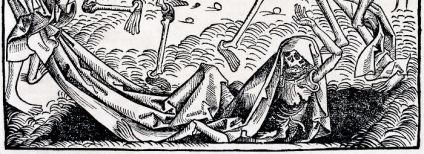Encounters with the Dead

Encounters with the dead were common in pre-modern society. With death rates from disease and illness high most people would come face-to-face with the dead at some time or other. But such events mostly occurred in private or at least domestic settings, environments where the encounter could be managed and socially regulated. In the early modern metropolis however the chance of public viewing of violent or unusual deaths was ever present.
It would seem that Londoners were particularly keen to look into the face of death. They thronged to the fields around Tyburn to witness the last death throes of the condemned, or journeyed to the waterside at Wapping to celebrate the execution of pirates. But London presented other opportunities to connect with the dead. Those recovered from rivers and ponds were often exposed to public view in an attempt to provide an identity. In March 1730 the Daily Courant reported that ‘on Thursday last in the afternoon a man was taken out of the New River Head near Sadler’s Wells, who is supposed to have been murdered and robbed, by his pockets being turned out, and being cut and mangled very much; he was carried to Clerkenwell burying ground, to be seen openly, if that any person should know to whom he belonged.’ That, via word of mouth, crowds would have gathered to view the corpse is not unlikely.
On another occasion when the drowned body of a woman was discovered on the Thames shoreline in 1754 it drew an audience. In particular James Gould a bargeman set aside the possible protestations of his wife and child as he diverted their Sunday walk to get a closer look. As he later recounted at the Old Bailey; ‘Upon Sunday the 18th of November, as I, my wife, and child, were coming from Chiswick to Hammersmith we heard of a drowned woman; I was determined to walk down to see her, and walked as far as the mud would let me go; she lay in the mud and water, but over-hawling her very strictly I lifted up her head’ and by doing so he gazed directly into the face of death. Others waited their turn until several men had recovered the body of Elizabeth Webb and carried it to drier land before taking a closer look. Henry Smith and Robert Boyle helped to ‘threw her upon a piece of board and carry her up to the Black-Lion and laid her there; there were five or six of us carried her up’. Boyle also observed that ‘I believe there were a hundred people on the bank side at that time.’
In what was perhaps an even more macabre engagement with the dead, a house fire in 1687 drew a certain type of audience. A pamphlet published in recognition of the catastrophic event (A True Account of that Dreadful Fire which happened in the House of Mr Samuel Seaton) noted that ‘The bodies … were carried to a neighbour’s house; and there lay as affrightening spectacles to people, who flocked to see them’. One can readily imagine the press of men, women and children at the doors and windows of the house as they jostled to catch a glimpse, or a smell, of the charred corpses of the seven recently deceased inhabitants including Mr Seaton, his wife and their new-born child.
Leave a comment